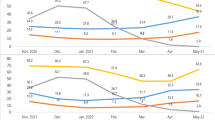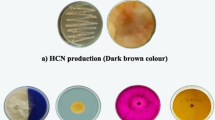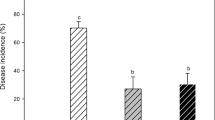Abstract
Trichoderma harzianum was applied to cucumber and pepper seedlings as a peat-bran preparation incorporated into the propagative mixture in a commercial production nursery. On marketing day (after 18 and 30 days for cucumber and pepper, respectively), significant increases of 23.8% and 17.2% in seedling height, 96.1% and 50% in leaf area, and 24.7% and 28.6% in plant dry weight were observed in cucumber and pepper seedlings, respectively, as compared to their non-treated counterparts.Trichoderma-treated seedlings were much more developed and vigorous and had higher chlorophyll contents. No significant differences were found in N, P or K content between treatments. Cucumber seedlings were then transplanted to a commercial greenhouse and analyzed over two successive growth cycles following soil fumigation with methyl bromide (500 kg/ha). Results revealed theTrichoderma-treated plants to be more resistant to damping-off disease. During the first cycle, immediately after soil fumigation, no damping-off was observed with either treatment, except in border beds where 4% of the non-treated plants died, as compared to no damping-off in theTrichoderma-treated plants. During the second growing cycle however, significant reductions in damping-off of 67% and 52% were obtained in middle and border beds, respectively, as compared to the non-treated controls.
Similar content being viewed by others
References
Baker R (1989) ImprovedTrichoderma spp. for promoting crop productivity. Trends in Biotechnology 7: 34–38
Baker R, Elad Y and Chet I (1984) The controlled experiment in the scientific method with special emphasis on biological control. Phytopathology 74: 1019–1021
Chang Y-C, Chang Y-C, Baker R, Kleifeld O and Chet I (1986) Increased growth of plants in presence of the biological control agentTrichoderma harzianum. Plant Disease 70: 145–148
Chet I (1987)Trichoderma-application, mode of action, and potential as biocontrol agent of soilborne plant pathogenic fungi. In: Chet I, ed, Innovative Approaches to Plant Disease Control, pp 137–160. John Wiley & Sons, NY
Chet I (1990) Biological control of soilborne pathogens with fungal antagonists in combination with soil treatments. In: Hornby D, Cook RJ, Henis Y, Ko WH, Rovira AD, Schippers B, Scott PR, eds, Biological Control of Soilborne Pathogens, pp 15–25. CAB Publishing House, NY
Chet I, Barak Z and Oppenheim A (1993) Genetic engineering of microorganisms for improved biocontrol activity. In: Chet I, ed, Biotechnology in Plant Disease Control, pp 211–235. John Wiley
Elad Y, Chet I and Henis Y (1982) Degradation of plant pathogenic fungi byTrichoderma harzianum. Canadian Journal of Microbiology 28: 719–725
Harman GE and Lumsden RD (1990) Biological disease control. In: Lynch JM, ed, The Rhizosphere, pp 259–280. Wiley Interscience
Kleifeld O and Chet I (1992)Trichoderma-plant interaction and its effect on increased growth response. Plant and Soil 144: 267–272
Papavizas GC (1985)Trichoderma andGliocladium: Biology, ecology and the potential for biocontrol. Annual Review of Phytopathology 23: 23–54
Paulitz Y, Windham M and Baker R (1986) Effect of peat vermiculite mixes containingTrichoderma harzianum on increased growth response of radish. Journal of the American Society of Horticultural Science 111: 810–814
Shenker M, Oliver I, Helmann M, Hadar Y and Chen Y (1992) Utilization by tomatoes of iron mediated by a siderophore produced byRhizopus arrhizus. Journal of Plant Nutrition 15: 2173–2182
Sivan A and Chet I (1986) Possible mechanism for biological control ofFusarium spp. byTrichoderma harzianum. British Crop Protection Conference on Pests and Diseases 865–872
Sivan A and Chet I (1992) Microbial control of plant diseases. In: Mitchell R, ed, New Concepts in Environmental Microbiology, pp 335–354. Wiley-Liss
Sivan A and Chet I (1993) Integrated control of Fusarium crown and root rot of tomato withTrichoderma harzianum in combination with methyl bromide or soil solarization. Crop Protection 12: 380–386
Sivan A, Elad Y and Chet I (1984) Biological control effects of a new isolate ofTrichoderma harzianum onPythium aphandiermatum. Phytopathology 74: 498–501
Sivan A, Ucko O and Chet I (1987) Biological control of Fusarium crown rot of tomato byTrichoderma harzianum under field conditions. Plant Disease 71: 587–592
Windham MT, Elad Y and Baker R (1986) A mechanism for increased plant growth induced byTrichoderma spp. Phytopathology 76: 518–521
Author information
Authors and Affiliations
Rights and permissions
About this article
Cite this article
Inbar, J., Abramsky, M., Cohen, D. et al. Plant growth enhancement and disease control byTrichoderma harzianum in vegetable seedlings grown under commercial conditions. Eur J Plant Pathol 100, 337–346 (1994). https://doi.org/10.1007/BF01876444
Accepted:
Issue Date:
DOI: https://doi.org/10.1007/BF01876444




